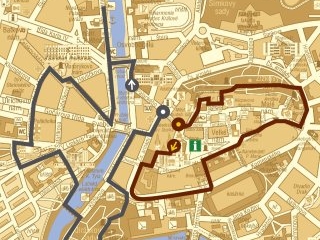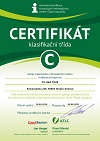Walking Tour I. | Walking Tour II. | Giant Aquarium | Botanical Garden of Medical Plants | Museum of Aviation | Labe Steamers | Autocamping Silver Pond
Walking Tour I.
Brown stands

There are thirteen stops on tour no I which will show you round the historic centre of the city. For better orientation, the tours are marked by arrows on the kerbs.
The tour starts at the Information Centre on Velké Square, follows to the staircase on Kozinka, past former brewery back to the square and then past the baroque Church of the Assumption of the Blessed Virgin Mary to the renowned Gočár’s Staircase. From Malé Square the tour continues past Liska’s Evangelical Church to Žižka’s Gardens and through the park back to Klicpera’s Theatre. The lanes of the old town will lead you to the City Music Hall, former Bishop’s seminary with the Chapel of St. John of Nepomuk. From here the Zielger Street will take you to Svatojánské Square where the tour ends.1. White Tower

The renaissance bell tower, completed in 1589, used to serve as the city’s fire tower and watchtower. Its name is related to the material used - white stone.
The Augustin bell in the tower is the second biggest bell in Bohemia only after the Zikmund bell in Prague. It was cast already in 1509 by Ondřej Žáček, a bell founder from Hradec Králové and before it was installed in the bell tower, it had been hanged on a wooden stand at St. Kliment’s Church near the foundations of the tower. It weighs ten tonnes and has more than two meters in diameter. On special occasions and fairs, more than eight men had to ring the bell.The original astronomical clock by clockmaker Vavřinec from 1591 was replaced by Josef Božek’s device by from 1829. The modern electrical device held on to the unusual system of timekeeping where the longer minute hand shows hours and shorter hour hand minutes. The tower is 71.5 metres high.
Address : Franušova St, Velké náměstí
Contact : Hradecká kulturní a vzdělávací společnost s.r.o. (Hradec society for culture and education), třída ČSA 300, 500 01 Hradec Králové, phone: +420 495 513 966, www.adalbertinum.cz
2. Cathedral of the Holy Spirit
 The gothic brick building of the Church of the Holy Spirit ranks among the
major historic sights of the town. It was established by Queen Eliška Rejčka
in 1307. In 1424, Jan Žižka of Trocnov, major military leader of the Hussite
movement, was temporarily buried here. When the diocese was established
in 1664, the church became a cathedral. Between 1864 and 1874 the church
got its neogothic appearance. The towers were renovated in 1901.
The gothic brick building of the Church of the Holy Spirit ranks among the
major historic sights of the town. It was established by Queen Eliška Rejčka
in 1307. In 1424, Jan Žižka of Trocnov, major military leader of the Hussite
movement, was temporarily buried here. When the diocese was established
in 1664, the church became a cathedral. Between 1864 and 1874 the church
got its neogothic appearance. The towers were renovated in 1901.
The cathedral is fifty-six meters long and thirty-three meters high. On the central bolt of the organ loft there is the oldest depiction of the city’s coat of arms from 1463. A late gothic triptych from 1494 is placed on the neogothic altar. The tin baptismal font from 1406 is also of great value. The relief of four Evangelists on the sand stone pulpit is an early work of a renowned Czech sculptor J. V. Myslbek.
Address : Náměstí Jana Pavla II.
Contact : Děkanství královéhradecké (Hradec Králové Deanery), náměstí Jana Pavla II., 500 01 Hradec Králové, phone: +420 495 511 353, www.diecezehk.cz
3. Marian Plague Column
 The dominant landmark of Velké Square is the nearly twenty meters
high baroque Marian column, which was built in remembrance of that
fact that the city and its population was spared from the plague epidemic
in 1716. The column was probably erected by the architect and sculptor
G. B. Bulla and its origin dates back to 1717.
The dominant landmark of Velké Square is the nearly twenty meters
high baroque Marian column, which was built in remembrance of that
fact that the city and its population was spared from the plague epidemic
in 1716. The column was probably erected by the architect and sculptor
G. B. Bulla and its origin dates back to 1717. The sandstone column is topped with a statue of the Virgin Mary. On the pedestal there are sculptures of St. Anne, St. Ivan, St. Charles Borromeo and St. John of Nepomuk, St. Wenceslaus, St. Joseph, St. Sebastian and St. Lawrence. In the two niches there are sculptures of St. John of Nepomuk and St. Rosalia. For the first time, the new coat of arms of Hradec Králové was depicted here. It is a lion carrying letter G (Gradec). On the pedestal, there is also a relief of St. Francis Xavier and St. Rosalia.
4. Gallery of Modern Art
 The gallery of modern art is found in an Art Nouveau building by
architect Osvald Polívka from 1912. For the range and quality of its art
collections the gallery ranks among the most prestigious galleries in the
Czech Republic. The decoration of the building includes statues by Ladislav
Šaloun, a major figure of the Art Nouveau style in the Czech Republic.
The gallery of modern art is found in an Art Nouveau building by
architect Osvald Polívka from 1912. For the range and quality of its art
collections the gallery ranks among the most prestigious galleries in the
Czech Republic. The decoration of the building includes statues by Ladislav
Šaloun, a major figure of the Art Nouveau style in the Czech Republic.
The exposition focuses on modern 20th-century art, and the works of Bohumil Kubišta, Jan Zrzavý, Josef Váchal, Jan Preisler, Jindřich Štyrský, Toyen, František Muzika, Josef Šíma, Václav Špála and Josef Čapek. The second half of the 20th century is represented by the works of Mikuláš Medek and Jiří Kolář, and the statues of Olbram Zoubek. The gallery regularly organises temporary exhibitions with accompanying events.
Address : Velké náměstí 139
Contact : Velké náměstí 139, 500 03 Hradec Králové phone: +420 495 514 893, www.diecezehk.cz
5. Church of the Assumption of the Virgin Mary
 The baroque Church of the Assumption of the Blessed Virgin Mary was
built by the Jesuits between 1654 and 1666 according to the project of the
Italian architect Carlo Lurago. In 1762, it was extensively damaged by fire.
The only parts of the original decoration that remained preserved are the
frescos in St. Ignatius’s Chapel and the painting Glorification of St. Ignatius
of Loyola by Petr Brandl (around 1730). The altar painting of the Assumption
of the Blessed Virgin Mary by Kristián Noldinger and other decoration
was realised only after 1765. In the church, there is also a valuable organ,
the oldest one in Hradec Králové. It is a two-manual baroque instrument
from 1765, constructed by Josef Streussel (1732 - 1776), an organ maker
from Kralice. The church towers were built only in 1857. The interiors were
rebuilt several times, while the largest reconstruction took place at the
beginning of the 20th century and in 1941 - 1945.
The baroque Church of the Assumption of the Blessed Virgin Mary was
built by the Jesuits between 1654 and 1666 according to the project of the
Italian architect Carlo Lurago. In 1762, it was extensively damaged by fire.
The only parts of the original decoration that remained preserved are the
frescos in St. Ignatius’s Chapel and the painting Glorification of St. Ignatius
of Loyola by Petr Brandl (around 1730). The altar painting of the Assumption
of the Blessed Virgin Mary by Kristián Noldinger and other decoration
was realised only after 1765. In the church, there is also a valuable organ,
the oldest one in Hradec Králové. It is a two-manual baroque instrument
from 1765, constructed by Josef Streussel (1732 - 1776), an organ maker
from Kralice. The church towers were built only in 1857. The interiors were
rebuilt several times, while the largest reconstruction took place at the
beginning of the 20th century and in 1941 - 1945.Address : Náměstí Jana Pavla II.
Contact : Děkanství královéhradecké (Hradec Králové Deanery), náměstí Jana Pavla II., 500 01 Hradec Králové, phone: 495 511 353, www.diecezehk.cz
6. Gočár’s Staircase
 The staircase Na Kropáčce is an early work of Czech modern architecture
which had no artistic parallel at the time it was built (1909 - 1910).
It is named after its author, architect Josef Gočár, who had to deal with
a demanding urbanistic challenge - to close the vacant space after the elevated
tank Kropáčka that had been pulled down. The architect approached
this typical utility work with extraordinary sense for composition and material
used, and thus shifted the development of Czech modern architecture.
The staircase Na Kropáčce is an early work of Czech modern architecture
which had no artistic parallel at the time it was built (1909 - 1910).
It is named after its author, architect Josef Gočár, who had to deal with
a demanding urbanistic challenge - to close the vacant space after the elevated
tank Kropáčka that had been pulled down. The architect approached
this typical utility work with extraordinary sense for composition and material
used, and thus shifted the development of Czech modern architecture.7. District Court
 The staircase Na Kropáčce is an early work of Czech modern architecture
which had no artistic parallel at the time it was built (1909 - 1910).
It is named after its author, architect Josef Gočár, who had to deal with
a demanding urbanistic challenge - to close the vacant space after the elevated
tank Kropáčka that had been pulled down. The architect approached
this typical utility work with extraordinary sense for composition and material
used, and thus shifted the development of Czech modern architecture.
The staircase Na Kropáčce is an early work of Czech modern architecture
which had no artistic parallel at the time it was built (1909 - 1910).
It is named after its author, architect Josef Gočár, who had to deal with
a demanding urbanistic challenge - to close the vacant space after the elevated
tank Kropáčka that had been pulled down. The architect approached
this typical utility work with extraordinary sense for composition and material
used, and thus shifted the development of Czech modern architecture.8. City Music Hall
 At present, the former Bishop’s seminary with the Church of St. John
of Nepomuk is used as the City Music Hall. It is found on the place where
the king’s castle stood until 1423. It was the seat of Bohemian queens Eliška
Rejčka and Eliška Pomořanská. The church and the seminary were built in
1709 - 1714 by master builder V. Schneider. The ground plan of the baroque
church is in the shape of a Latin cross. The interiors were decorated by wall
paintings by the monks of the Prague Emauzy Monastery in 1887.
At present, the former Bishop’s seminary with the Church of St. John
of Nepomuk is used as the City Music Hall. It is found on the place where
the king’s castle stood until 1423. It was the seat of Bohemian queens Eliška
Rejčka and Eliška Pomořanská. The church and the seminary were built in
1709 - 1714 by master builder V. Schneider. The ground plan of the baroque
church is in the shape of a Latin cross. The interiors were decorated by wall
paintings by the monks of the Prague Emauzy Monastery in 1887.Address : Zieglerova St 91-94
Contact : Hradecká kulturní a vzdělávací společnost s.r.o. (Hradec society for culture and education), třída ČSA 300, 500 01 Hradec Králové, phone: +420 495 513 966, www.adalbertinum.cz
Projekt je podporován Královéhradeckým krajem.












